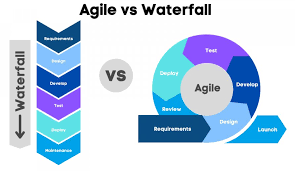
Selecting the right project management methodology is critical to the success of any project. Two of the most commonly used approaches are Agile and Waterfall. Each has its strengths, weaknesses, and ideal use cases, making it essential to understand their nuances before deciding which one aligns best with your project goals.
In this article, we’ll explore the key differences between Agile and Waterfall, their pros and cons, and how partnering with an Agile Development Company can ensure your project thrives in today’s dynamic business environment.
What is the Waterfall Methodology?
The Waterfall methodology is a linear, sequential approach to project management. It follows a strict order, where each phase must be completed before moving to the next. Commonly used in traditional industries like construction and manufacturing, Waterfall emphasizes thorough planning and documentation.
Key Phases of Waterfall
- Requirement Gathering: Detailed documentation of all project requirements.
- Design: Creation of system architecture and design documents.
- Implementation: Development of the product based on design specifications.
- Testing: Comprehensive testing to ensure the product meets requirements.
- Deployment and Maintenance: Delivery of the final product and ongoing support.
What is the Agile Methodology?
Agile is a flexible, iterative approach to project management. Unlike Waterfall, Agile breaks projects into smaller increments called sprints, each delivering a functional part of the product. Agile focuses on collaboration, adaptability, and continuous improvement, making it ideal for dynamic projects.
Core Principles of Agile
- Customer Collaboration: Frequent communication with stakeholders to ensure alignment.
- Iterative Development: Regular delivery of working product increments.
- Adaptability: Flexibility to accommodate changing requirements.
- Continuous Feedback: Regular reviews and adjustments to improve outcomes.
Key Differences Between Agile and Waterfall
|
Aspect |
Agile |
Waterfall |
|
Approach |
Iterative and flexible |
Linear and sequential |
|
Documentation |
Minimal, focused on collaboration |
Extensive, detailed upfront |
|
Timeline |
Adaptive to changes |
Fixed and predefined |
|
Customer Involvement |
Continuous throughout the project |
Primarily during the initial phase |
|
Risk Management |
Issues identified and addressed early |
Risks emerge late in the process |
|
Best For |
Dynamic, evolving projects |
Well-defined, stable projects |
Pros and Cons of Waterfall
Advantages
- Clear Structure: Each phase has a defined start and end, ensuring clarity.
- Thorough Documentation: Provides a comprehensive record of project requirements and design.
- Predictable Timelines: Ideal for projects with fixed budgets and deadlines.
Disadvantages
- Inflexibility: Difficult to adapt to changes once the project is underway.
- Delayed Testing: Errors are often discovered late, increasing the cost of fixes.
- Limited Customer Involvement: Stakeholders have minimal input after the initial phase.
Pros and Cons of Agile
Advantages
- Flexibility: Easily accommodates changing requirements.
- Faster Delivery: Incremental releases allow for quicker time-to-market.
- Improved Collaboration: Regular feedback ensures alignment with stakeholder expectations.
Disadvantages
- Requires Discipline: Teams must maintain consistent communication and coordination.
- Less Predictable Costs: Continuous changes can make budgeting challenging.
- Steep Learning Curve: Teams unfamiliar with Agile may require training and adjustment time.
When to Choose Waterfall
Waterfall is ideal for projects with:
- Well-Defined Requirements: Projects with clear, unchanging goals.
- Fixed Timelines and Budgets: Where predictability is a priority.
- Low Complexity: Simple projects that don’t require frequent adjustments.
Examples of Waterfall Projects
- Construction and infrastructure projects.
- Hardware development.
- Regulatory compliance initiatives.
When to Choose Agile
Agile is best suited for projects with:
- Evolving Requirements: Projects where goals may change over time.
- High Uncertainty: Innovative or experimental initiatives.
- Collaborative Teams: Where constant communication and feedback are essential.
Examples of Agile Projects
- Software and app development.
- Digital transformation initiatives.
- Marketing campaigns requiring real-time adjustments.
How an Agile Development Company Can Help
Partnering with an Agile Development Company ensures your project benefits from experienced teams, proven processes, and modern tools. Here’s how they add value:
- Expertise: Skilled developers and Agile coaches guide your project to success.
- Scalability: Adjust resources and priorities as needed without disrupting workflows.
- Customer-Centric Approach: Regular updates and feedback loops keep you in control.
- Risk Mitigation: Agile’s iterative nature identifies and resolves issues early.
Making the Right Choice for Your Project
Choosing between Agile and Waterfall depends on your project’s complexity, requirements, and goals. If your project demands flexibility, frequent updates, and collaboration, Agile is the clear winner. For projects with fixed requirements and timelines, Waterfall offers a structured approach.
Conclusion: Finding the Perfect Fit
Understanding the differences between Agile and Waterfall is essential for selecting the right methodology for your project. While Waterfall excels in predictability and structure, Agile’s adaptability and collaboration make it the go-to choice for dynamic, modern projects.
Looking for expert guidance in Agile development? Partner with Adequate Infosoft, a trusted Agile Development Company, to bring your project to life. Contact us at +91-120-4198878 today to explore how Agile can transform your business!





Leave a Reply